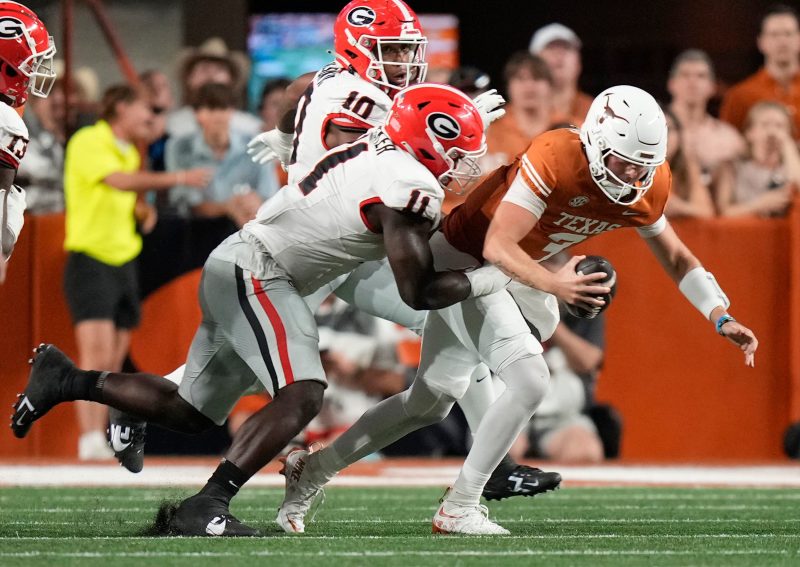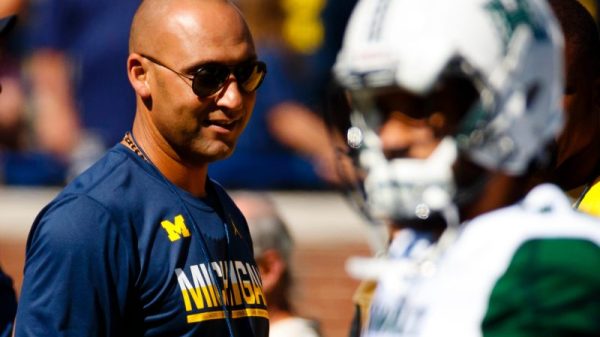College football functions just fine without conference divisions, but some tiebreaker rules we can actually understand would help.
Lane Kiffin’s suggestion makes sense: Incorporate CFP rankings to break messy ties in conference standings.
Kenny Dillingham quote about Big 12 championship game shows coaches don’t even understand how these tiebreakers work.
I hereby declare elimation of conference divisions a smashing success.
If you disagree, tell me whether you enjoyed Ohio State at Oregon, or Georgia at Texas, or Penn State at Southern California.
Games such as those would occur less frequently if conference divisions persisted, because teams in those matchups almost certainly would have been placed in opposite divisions.
Television ratings suggest you very much enjoyed those games.
Georgia-Texas recorded the highest television audience of any game this season, logging 13.2 million viewers, while Ohio State-Oregon (9.6 million viewers) remains the second-highest rated Big Ten game.
True, eliminating divisions meant Missouri and Kentucky didn’t face off in an SEC East ‘clash,’ and we had to miss out on Florida State-Syracuse (on, no!), but lo and behold, the world kept spinning.
Conferences threaded a needle by dumping divisions while preserving the most important league rivalries. All in all, pretty good deal. So, all’s well that ends well, yeah?
Well, not exactly.
Progress often comes at a cost. The price of axing divisions? Logjammed conference standings means that, in some cases, messy tiebreaker rules will be needed to determine conference championship matchups.
Within the SEC, a six-way tie for first place remains in play. The SEC’s complex tiebreaker rules include the phrase “capped relative scoring margin” as a factor that could be considered.
Now, we just need to find someone with four Ph.D.s and a quarter-million dollars in school loans to explain for us what “capped relative scoring margin” means.
A battle royale takes place toward the top of the Big 12 standings, too, where winning the conference championship likely will be the only avenue to playoff entry.
Asked about the Big 12’s tiebreaker scenarios, Arizona State coach Kenny Dillingham admitted, “I literally have no clue.”
“Somebody was telling me, if we win and somebody else loses, and then ranch dressing falls on a wing, I don’t really know,” Dillingham said. “Just, play the very best you can play, … and don’t get lost in the sauce.”
WEEKEND FORECAST: Week 13 college football picks for every Top 25 game
PLAYOFF PREDICTION: Colorado enters field, Alabama grabs first-round bye
A solution to the conference tiebreaker dilemma
Some in and around the sport have mused that these oversized conferences and muddy tiebreaker rules prove that divisions ought to be restored.
Forget that idea.
No need to rekindle the past. Don’t sacrifice the quality of the regular season just to make the conference championship matchup more straightforward. Instead of reviving divisions, come up with a set of tiebreakers that normal people can understand.
I propose this simple three-step system for determining conference championship matchups:
1. Conference records.
2. Head-to-head record among tied teams.
3. If teams with identical conference records remain tied after applying the head-to-head tiebreaker, use the College Football Playoff rankings to decide the conference championship matchup. The highest-ranked team among the tied teams earns the nod.
Would that be controversial? Sure.
At least we could understand it, though.
And, if we trust a committee to choose playoff teams, why shouldn’t that committee be qualified to settle a deadlock in the conference standings?
I’ve got company in this line of thinking.
“All this seems really complicated,” Mississippi coach Lane Kiffin said of the SEC’s tiebreaker procedure. “… I would think it would have been a lot easier to say, ‘What are the top two teams in the (CFP) rankings?’”
Divisions within conferences started as a business opportunity. Roy Kramer, after becoming the SEC’s commissioner, seized on a little-known NCAA rule that allowed a conference to conduct a football championship game if that conference included at least 12 teams and split into divisions.
So, the SEC hatched a plan, and in 1992 it launched its revolutionary conference championship.
A championship game meant more conference exposure and more revenue. Other conferences followed the SEC’s lead by expanding, splitting into divisions and hosting conference championships.
Decades later, the NCAA modified its rules, and now conferences of any size can conduct a conference championship game without splitting into divisions.
By changing the rules surrounding conference championships, the NCAA eliminated the reason why divisions were created. Once conferences gained permission to conduct championship games without divisions, most leagues unified the conference. Starting this season, the Sun Belt is the only Bowl Subdivision conference still split into divisions.
I don’t miss divisions. I do miss the clarity they brought to conference championship matchups, but that can be solved by a solution right in front of our face. The CFP rankings are there in plainsight. Use them.
Here’s what else I’m mulling in this “Topp Rope” view of college football:
Name to watch in 2025 coaching carousel
This shapes up as a quiet Power Four coaching carousel. That points to the carousel kicking into overdrive next season, with several high-profile jobs potentially coming open.
Who will emerge as a top commodity on the 2025 hiring circuit? Monitor SMU’s Rhett Lashlee. He’s steered the Mustangs to unabated success in their ACC debut. They’re in the thick of the playoff hunt.
While Indiana’s Curt Cignetti earned every bit of the fanfare he’s received for this Hoosiers uprising, Cignetti mania overshadows Lashlee’s feat.
Lashlee built on predecessor Sonny Dykes’ success with three consecutive winning seasons, this year ranking as his best yet.
By ACC standards, Lashlee enjoys a good gig. He’s positioned in rich recruiting terrain. SMU benefits from a formidable NIL collective, making it a player in the acquisition circuit.
SEC and Big Ten jobs are a siren’s call, though, and those two conferences unlock the path to the national championship. The ACC projects as a one-bid playoff league.
Lashlee played quarterback at Arkansas, and he was Auburn’s offensive coordinator when its 2013 team reached the national championship game.
Arkansas and Auburn could become two of several ‘Super Two’ conference jobs open next year.
Emails of the week
Mike writes: When I look at teams like South Carolina, Florida and Alabama, I see teams that have clearly improved as the season progressed. These teams now barely resemble what they were at the beginning of the season.
But when I look at Tennessee, I see a team that is no better now than it was in late August. The offense might even be worse.
My response: You’ll hear no disagreement from me, and, apparently, the CFP selection committee shares your view of the Vols’ stagnant progress. That’s reflected in Tennessee ranking behind fellow two-loss SEC teams Alabama, Ole Miss and Georgia in the latest rankings.
My response: ‘Baby cakes,’ now that’s one I haven’t heard. Kudos for originality.
My response: Careful, Jim, I wouldn’t want your fellow Irish fans to accuse you of SEC bias.
Three and out
1. Deion Sanders dismissed speculation that he’s got a foot out the door at Colorado, saying he’s got ‘a kickstand down.” Unrelated (or possibly related), I seem to recall my kickstand buckling and my bike toppling over every now and again when I was a kid. Kickstands aside, the more important indicator came Thursday, when blue-chip quarterback Julian Lewis committed to Colorado. Lewis, at least, believes Coach Prime will stay put.
2. Would coaches of playoff-positioned teams prefer to not earn selection for their conference championship game? My read on the situation: Most coaches would rather not risk the loss and instead head straight to the playoff. Most players would prefer to put it on the line and try to win the conference crown.
3. A low-key odd development from Tuesday’s CFP rankings: Alabama leapfrogged Miami, following the Tide’s blowout win over Mercer, while the Hurricanes had an open date. If you had Mercer influencing the playoff rankings on your bingo card, come claim your prize.
Blake Toppmeyer is the USA TODAY Network’s national college football columnist. Email him at BToppmeyer@gannett.com and follow him on Twitter @btoppmeyer. The ‘Topp Rope’ is his football column published throughout the USA TODAY Network. Subscribe to read all of his columns.






























